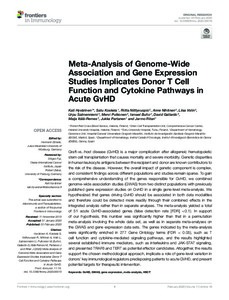Meta-Analysis of Genome-Wide Association and Gene Expression Studies Implicates Donor T Cell Function and Cytokine Pathways in Acute GvHD
Kati Hyvärinen; Satu Koskela; Riitta Niittyvuopio; Anne Nihtinen; Liisa Volin; Urpu Salmenniemi; Mervi Putkonen; Ismael Buño; David Gallardo; Maija Itälä-Remes; Jukka Partanen; Jarmo Ritari
Meta-Analysis of Genome-Wide Association and Gene Expression Studies Implicates Donor T Cell Function and Cytokine Pathways in Acute GvHD
Kati Hyvärinen
Satu Koskela
Riitta Niittyvuopio
Anne Nihtinen
Liisa Volin
Urpu Salmenniemi
Mervi Putkonen
Ismael Buño
David Gallardo
Maija Itälä-Remes
Jukka Partanen
Jarmo Ritari
FRONTIERS MEDIA SA
Julkaisun pysyvä osoite on:
https://urn.fi/URN:NBN:fi-fe2021042824045
https://urn.fi/URN:NBN:fi-fe2021042824045
Tiivistelmä
Graft-vs.-host disease (GvHD) is a major complication after allogeneic hematopoietic stem cell transplantation that causes mortality and severe morbidity. Genetic disparities in human leukocyte antigens between the recipient and donor are known contributors to the risk of the disease. However, the overall impact of genetic component is complex, and consistent findings across different populations and studies remain sparse. To gain a comprehensive understanding of the genes responsible for GvHD, we combined genome-wide association studies (GWAS) from two distinct populations with previously published gene expression studies on GvHD in a single gene-level meta-analysis. We hypothesized that genes driving GvHD should be associated in both data modalities and therefore could be detected more readily through their combined effects in the integrated analysis rather than in separate analyses. The meta-analysis yielded a total of 51 acute GvHD-associated genes (false detection rate [FDR] <0.1). In support of our hypothesis, this number was significantly higher than that in a permutation meta-analysis involving the whole data set, as well as in separate meta-analyses on the GWAS and gene expression data sets. The genes indicated by the meta-analysis were significantly enriched in 277 Gene Ontology terms (FDR < 0.05), such as T cell function and cytokine-mediated signaling pathways, and the results highlighted several established immune mediators, such as interleukins and JAK-STAT signaling, and presented TRAF6 and TERT as potential effector candidates. Altogether, the results support the chosen methodological approach, implicate a role of gene-level variation in donors' key immunological regulators predisposing patients to acute GVHD, and present potential targets for therapeutic intervention.
Kokoelmat
- Rinnakkaistallenteet [27094]
